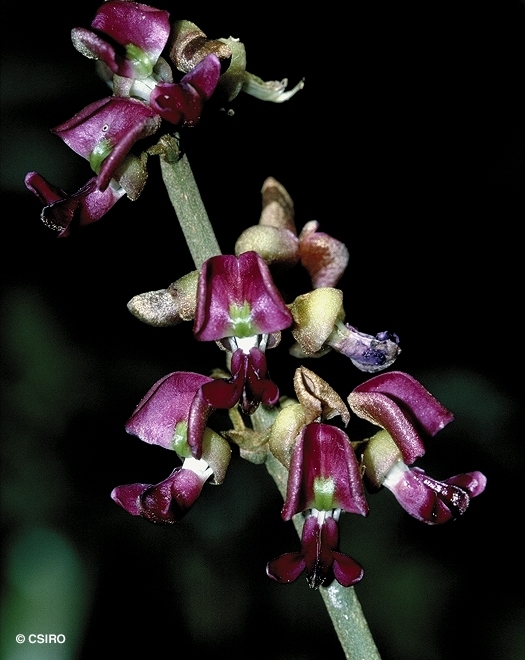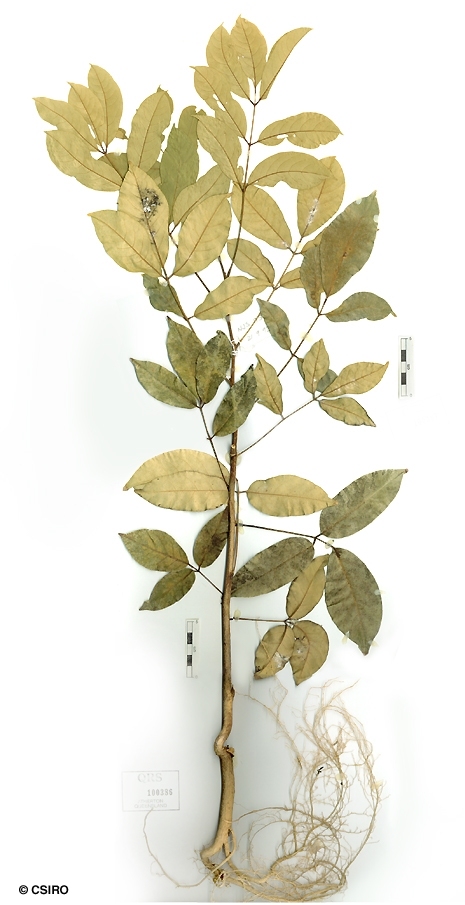Australian Tropical Rainforest Plants - Online edition
Ibatiria furfuracea W.E.Cooper









Cooper, W.E. et al (2019) Australian Systematic Botany 32: 376-378. Type: "Australia. Queensland: Galaji Nature Reserve, Topaz, 13 Nov. 2016, W.Cooper 2389, J.Clarkson & C.Pannell (holo:CNS! (3 sheets + spirit); iso: BRI, CANB, K, L, LAE, MO, NSW)."
Vine, twiner to canopy, diameter up to 160 mm; bark brown–grey with longitudinal or diagonal striations creating an almost cross-hatched pattern and becoming thinly flaky at edges of patterning; exudate red; leafy stems with round to elongated lenticels. Indumentum golden-coppery or silvery. Cataphylls: 1 or 2 emerging before the first true leaves. Stipules ovate or triangular, 1-4 mm long, 1-2.5 mm wide, sericeous.
Leaves alternate, imparipinnate, alternate; rachis + petiole 85-225 mm long, pubescent to glabrescent, not chanelled, pulvinus at base 5-13 mm long and 3.5-5 mm wide, wrinkled, hairy; petioles 60-110 mm long; stipels absent; lateral petiolules thickened, 5-8 mm long, wrinkled, pubescent; terminal petiolules + pulvinus 5-28 mm long, sericeous or pubescent; leaflets opposite, 7-9, discolorous, elliptical, obovate-elliptical, 35-135 mm long and 17-52 mm wide, leathery, upper side glabrous and shiny, underside sericeous and shiny, base cuneate or rounded, apex acuminate and sometimes with a retuse or mucronulate tip, margin entire; venation brochidodromous; primary vein flush or slightly sunken on upper side of dried specimens, raised on underside; secondary veins 7-14 pairs, flush on upper side and raised on underside of fresh specimens, raised on both sides of dried specimens; tertiary venation reticulate. Young shoots densely clothed in pale brown to golden hairs.
Inflorescence axillary, supra-axillary or terminal, a panicle or pseudoraceme 30-360 mm long, sometimes interspersed with whole compound leaves towards base, rachis sericeous; bracts at base of brachyblasts similar to stipules, 1.5-2 mm long, triangular, sericeous; brachyblasts 1-4-flowered, conspicuous, wart-like, ca. 1.25 mm long, sericeous. Flowers: no fragrance detected, papilionate, diameter 8-11.5 mm, maroon-red; pedicels 2.5-3.8 mm long, sericeous; calyx cup-shaped, 2-3.5 mm long, 4-4.2 mm wide, sericeous abaxially, margin entire and not lobed, if teeth present these are minute and hidden by sericeous hairs, green or pinkish, margin incurved; bracteoles triangular, paired at base of calyx or on upper pedicel, 1-2 mm long and ca. 1 mm wide, sericeous; standard almost orbicular, 7-11 mm long (including claw 2.5-3 mm long) and 7-8.5 mm wide, sericeous abaxially except for glabrous margin, sparse minute hairs on inner surface, base cuneate, apex emarginate, basal callosities longitudinal and green; wings oblong-falcate, glabrous, 6-7.5 mm long and 3-3.5 mm wide, margin entire; auricles absent, upper base truncate or rounded, lower base cuneate, lateral pockets absent; keel oblong, connate at apex, 6-8 mm long, 2.3-3 mm wide, sparsely sericeous, upper base cuneate, auricles absent, apex obtuse, margin entire, lateral pocket absent; stamens 10, of equal length, diadelphous with basal fenestrae, staminal tube ca. 6.5 mm long, stamens of similar length; anthers bilocular, alternately basifixed and dorsifixed, glabrous; disc annular, lobed, shortly tubular, diameter ca. 2 mm; ovary sessile, long-ovoid, 6.5-7.5 mm long, pubescent; style recurved, with a few sparse minute hairs or glabrous; stigma capitate; ovules 1 or 2, diameter ca. 0.5 mm.
Fruit an indehiscent and somewhat woody follicle or pod (becomes dehiscent along a solitary suture line after falling from plant and germination is initiated), ovoid, obovoid, swollen, rarely laterally compressed, 55-107 mm long, 55-84 mm wide and thick; mesocarp 7-20 mm thick around seed section, hard and granular; epicarp 1-2 mm thick, scurfy; seeds 1 or rarely 2, globose, ovoid or obovoid when solitary, hemispherical when 2-seeded, 50-90 x 40-55 x ca. 46 mm, testa papery, chestnut-brown, reticulate; cotyledons cream-coloured; radicle lateral or central, ca. 4 mm long; hilum diameter 2.25-2.50 mm; germination hypogeal.
Cataphylls, 1 or 2, produced before the first true leaves. First true leaf bifoliolate, compound leaf axis extending beyond the leaflets as a linear structure about 3 mm long. Second leaf trifoliolate, leaflets elliptic. At the tenth leaf stage: leaf pinnate with about 7 leaflets, leaflet blades elliptic, apex acuminate, base cuneate to obtuse. Lateral veins about 9-11 on each side of the midrib and forming loops inside the blade margin. Stalk of the terminal leaflet longer than those of the lateral leaflets. Lower leaflet surface, compound leaf rhachis, leaflet stalks and stem densely clothed in brown appressed hairs. Stipules triangular, about 2 mm long, densely clothed in brown hairs. Seed germination time 48 to 166 days.
Callerya sp. Beatrice Creek (L.S.Smith 10487) [Provisional HISPID Phrase Name]. Callerya sp. Beatrice River (L.S.Smith 10487) [Provisional HISPID Phrase Name]. Millettia sp. Boonjee LA (BH 7675) [Provisional HISPID Phrase Name]





